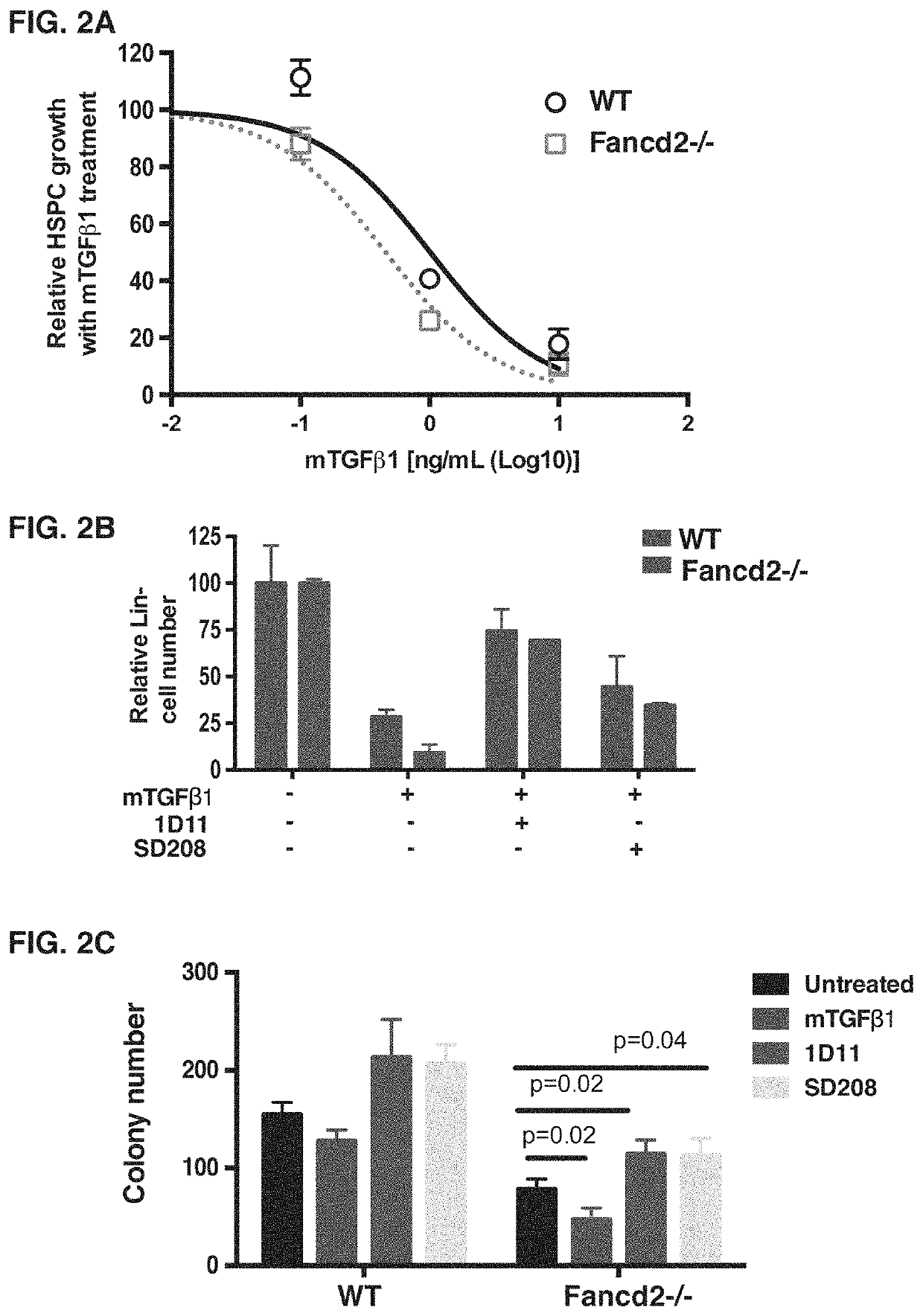Anti-TGF-beta antibody for the treatment of fanconi anemia
a technology of anti-tgfbeta and fanconi anemia, which is applied in the field of anti-tgfbeta antibody for the treatment of fanconi anemia, can solve the problems of increased binucleate bone marrow cells and apoptosis, progressive bone marrow failure, and compromised clonogenicity, and achieve the inhibitory effect of mtg
- Summary
- Abstract
- Description
- Claims
- Application Information
AI Technical Summary
Benefits of technology
Problems solved by technology
Method used
Image
Examples
example 1
ethods
[0069]Animals
[0070]We generated Fancd2− / − mice as previously described12. C57BL / 6J-CD45.1, and C57BL / 6J-CD45.2 mice were obtained from mice were purchased from The Jackson Laboratory. All mice were in C57BL / 6J background, and were bred and maintained in a temperature- and humidity-controlled environment and given unrestricted access to 6% chow diet and acidified water. We treated WT and Fancd2− / − mice with 0.3 mg / kg MMC to induce bone marrow failure. The neutralizing anti-mouse TGFβ monoclonal antibody 1D11 was provided by Genzyme, and administrated mice at 10 mg / kg by intraperitoneal injections three time per week. Animal experiments were performed following the approved protocol of the Animal Care and Use Committee at the Dana Farber Cancer Institute.
[0071]Hematopoietic Stem / Progenitor Cell Culture and Flow Cytometry Analysis.
[0072]For mouse hematopoietic stem / progenitor cell culture, Lin− cells were cultured in vitro in StemSpan SFEM media with 10 ng / mL SCF, 20 ng / mL IGF-2,...
example 2
way Inhibition Corrects Compromised Stem Cell Function of FA Mice
[0099]Bone marrow failure in FA results from impaired stem cell function caused by endogenous genotoxins2,28,32. Additionally, compared to WT HSPCs, Fancd2− / − HSPCs are hypersensitive to TGFβ (FIG. 2A). Therefore, we hypothesized that inhibition of TGFβ pathway may correct the defective function of stem cells collected from FA mice. To block the TGFβ pathway, we use the anti-murine TGFβ monoclonal antibody 1D11, because it has been shown to promote the regeneration of bone marrow in murine models. Blockage of TGFβ using this neutralizing antibody 1D11 promotes multilineage hematopoietic regeneration in the 5-FU-treated myelosuppression murine model21. Treatment with 1D11 antibody significantly blocked the activation of the TGFβ pathway in murine stromal cells, and rescued MMC sensitivity of Fancd2− / − stromal cells (FIG. 1A). Importantly, 1D11 treatment also corrected the suppressive effects caused by either exogeneous ...
example 3
hway Inhibition Rescues Acetaldehyde-Induced Genotoxicity in HSPCs from FA Mice
[0101]DNA damage induced by the endogenous genotoxic agents, such as acetaldehyde, causes the attrition of HSCs, leading to spontaneous bone marrow failure in murine FA models (Garaycoechea et al., 2012; Langevin et al., 2011). We reasoned that blockade of the TGF-β pathway may contribute to the repair of acetaldehyde-induced DNA damage in FA HSCs. As expected, bone marrow cells from Fancd2− / − mice were sensitive to acetaldehyde exposure. The neutralizing anti-TGF-β antibody 1D11 treatment counteracted the genotoxic effects of acetaldehyde, and rescued the growth and clonogenic capacity of Fancd2− / − HSCs or Lin−cells from bone marrow (FIGS. 4A and 6A). To directly measure the protective effect of 1D11 on the survival of HSPCs after acetaldehyde exposure, a stem cell transplant was performed. The percentage of donor-derived cells at 4 and 16 weeks post transplantation was higher in recipients of 1D11 treat...
PUM
 Login to View More
Login to View More Abstract
Description
Claims
Application Information
 Login to View More
Login to View More - R&D
- Intellectual Property
- Life Sciences
- Materials
- Tech Scout
- Unparalleled Data Quality
- Higher Quality Content
- 60% Fewer Hallucinations
Browse by: Latest US Patents, China's latest patents, Technical Efficacy Thesaurus, Application Domain, Technology Topic, Popular Technical Reports.
© 2025 PatSnap. All rights reserved.Legal|Privacy policy|Modern Slavery Act Transparency Statement|Sitemap|About US| Contact US: help@patsnap.com



